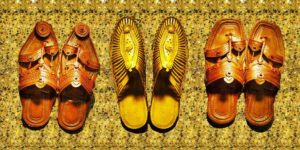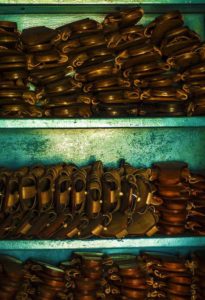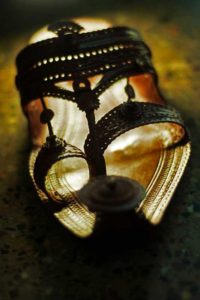স্থাপত্য পাবলিশার্স
বর্ধমান । কোন্নগর । কোলকাতা
Sthapatya Publishers
Burdwan | Konnagar | Kolkata
info.sthapatya@gmail.com
Shubhayan M: +918653792921
Arunava S: +9194323 43169
স্থাপত্য পাবলিশার্স
বর্ধমান । কোন্নগর । কোলকাতা
Sthapatya Publishers
Burdwan | Konnagar | Kolkata
info.sthapatya@gmail.com
Shubhayan M: +918653792921
Arunava S: +9194323 43169
Trending
Get real time updates directly on you device, subscribe now.
Situated on the banks of river Panchaganga in the south-west region of Maharashtra, the historic city of Kolhapur derives its name from the mythical story of Kolhasur– a demon who was slain by Goddess Mahalakshmi. Nested in the serene laps of the Sahyadri range, this remarkable land of splendid temples is the religious pride of Maharashtra. Focused around the Ambabai (Mahalaxmi) Temple, this city is also known as ‘Dakshin Kashi’; there is a strong belief that after one worships Lord Balaji at Tirupati, offering prayers to goddess Mahalakshmi is essential to complete the pilgrimage. The town is gifted with an incredible archeological & ethnic heritage, magnificent temples, monuments, forts, lakes, and gardens. Kolhapur is world-famous for Kolhapuri Chappals & jaggery. Flushed with tourists all around the year, this city is equally famous for special Kolhapuri Misal, Kolhapuri Rassa, and many more mouthwatering delicacies.
Having given a basic brief on the small but colorful town of Kolhapur, let’s get into the details of Kolhapri Chappals, the indigenous footwear from the town which is world-famous for its regal stature, artistry, and demand amongst the fancy folks.

Conceptualized as early as the 13th Century, this form of traditional craft saw a steady boost under the encouragement of Shahu Maharaj of Kolhapur. Shahu Maharaj was known to be a keen follower of crafts, and his reign saw artisans actively working to develop and perfect new items of daily use; they were encouraged to develop newer varieties of footwear for the king, and hence, Kolhapuri Chappals came into existence. Previously known by names like Kapashi, Paytaan, Kachkadi, Bakkalnali, and Pukari, the first major breakthrough was achieved in 1920 with the Saudagar family developing an indigenous design which was thinner than the original and had 2 side flaps, giving it the name ‘Kanwali’. This design received accreditation when the-then famous business house JJ & Sons of Bombay noticed it and ordered twenty pairs of this new design for sale in Bombay. An increase in demand led the Saudagar family to further explore designs and materials and perfecting the craft before teaching the skill to the artisans of the villages to meet the demand-supply chain. Further orders from cities like Calcutta, Madras as well as from the British Imperial house sealed the deal, establishing the stronghold of these chappals in Kolhapur. At present, the Chamar community does the hereditary occupation of tanning and leatherwork. Subash Nagar of Kolhapur is one of the main areas, where about 15-20 artisans together make the Kolhapur chappals.
In subsequent years, the product has seen considerable advancement in the design, usage of materials, usability and aesthetics. Presently, there exists different product range based on gender and age; the kapshi, kurundawdi and shahu are models for the male users, chepli, mayuri, angutha patta being models for females. Specially crafted pieces also exist for kids, bachkani zarigonda and pawda being two of those!
The entire procedure can be divided into three stages, the tanning of leather, preparing the chappal and finally packaging the finished product and distribution. While there are organizations bringing all three of these under one roof, most of the workshops only concentrate on one stage, with the raw materials being bought from tanneries and the distribution being outsourced to a suitable channel.
The chappal industry requires two types of leather- the hard variety obtained from cow or buffalo and a softer variety from goats or sheep. Once the raw leather is procured from the slaughterhouse, it takes an elaborate and repetitive procedure to tan it into the usable product. The raw skin is cut and immersed in brine vats for a couple of days to remove residual blood, meat and stench as well. The treated skins are then continuously rubbed with choona (lime) for a week or more to ensure complete removal of any hair or flesh. Having cold washed these lime-treated skins, the tanning procedure of leather starts. Two locally available natural ingredients named babool sal and hirda is used; these are finely ground and mixed with fresh water to produce a solution that is used in the tanning. The processed skins are tied into bags filled with this solution and left hanging for a continuous span of four days. The procedure is repeated with the other side of the skin as well, confirming even coloring of the skin. Once treated, they are given one final cold wash and left to dry for three days. The ready leather is then sold to the manufacturers by weight; a skin weighing 6-7 kg usually sets back the manufacturer by 1200-1500 rupees.
Making the footwear involves two parallel activity- making the sole (or the bottom of the shoe) and the strap or the patta of the shoe. The hard leather is necessary for the sole, and the softer variety is put to use for making the top of the chappal as well as straps and decorations.
For making the sole, the leather is washed in water for thirty minutes and brushed manually to remove any dirt or unwanted material that may interfere with comfort. The leather then goes through a procedure called skiving; any uneven surfaces in the leather are cut off using a special arc-shaped knife and then it is smoothened with the help of Kurpa, an extremely sharp crescent-shaped blade. Plastic stencils of different sizes are then used to outline shapes on the smooth leather prior to cutting them using Raapi, a special knife which resembles an ax. Heels are cut out similarly from hard leather. The upper portion of the sole which will be in contact with the human feet is generally made out of softer leather from the facial portion of cows or buffalo. The ears are cut out from goat leather. Once the individual parts are ready, they are glued together by using cobbler’s gum and set aside to dry. Once dry, the soles are ready to be stitched. Workers use nylon thread and the cobbler’s needles are dished in bee wax for easier infiltration. Stitching makes the sole tougher and adds to the aesthetic appeal as well. The soles are given a final appearance by cutting off the extra thread and leather to give a cleaner look. The soles are then polished with herbal colors; natural pigments are mixed with kerosene and applied using brush. The sole is finalized with one last round of polish ensuring quality finish to the product.
Softer leather from goats or sheep is used for making the straps or patta. Stencils are used to mark patterns on the leather which are then cut and dried under the sun for a few hours. Smaller parts are cut depending on the design. Additional parts like toe strap, veni strap are also cut similarly. After drying, these leathers are hammered to obtain the required thickness. Punching dies are used to create patterns on the leather as per the design. After trimming excess leather, the straps are machine-stitched and decorated using golden or red strings. After attaching the veni, it is allowed to sit for a day. The straps are polished in a similar manner to the sole and are allowed to sit for a day. It finally becomes ready after a final polish.
Once the individual parts are ready, the final assembly involves a selection of parts for a particular design. Markings and cuts are done on the sole for inserting the straps. They are glued and stitched in position by expert artisans specialized in assembly. The process ends with the addition of extra parts, trimming of extra parts and a final set of polish, ensuring a quality look to the finished product. After a round of quality inspection, it becomes available for shipping.
The chappals are generally shipped in plastic packets tied tightly inside a gunny bag.

The product is poorly packed and distributed, the network of distributors is quite long and inefficient, with the intermediaries sharing a major portion of the profit while artisans are underpaid. Most of the workers have barely passed high school and has been introduced into the business once old enough.
Despite being one of the most sought-after products, the industry is suffering from a range of complications including low wages, inconsistent products, and disgruntled customers. The entire network of circulation needs to be trimmed in order to bring consistency in price and wage models. Standardization of size is extremely important with a necessary upgrade in tools and expertise to make the production faster and cheaper.
Reviving this dying, yet interesting craft will require earnest and willful help from the government. Setting up proper infrastructure and distribution channels with the formulation of a strategic business model and implementing it on-field is crucial to ensure subsistence. Being an ardent lover of traditional cultures and artifacts, it is agonizing for me to see the poor state of affairs of a century-old tradition. What sets me off further is the realization that while Indians have long valued and taken pride in their cultural and ethnic diversities, majority of them are not willing to inch a step towards protecting these gharanas of traditional expertise and crafts. The government wouldn’t be of much help unless the people realize the true value that lies in these cultures; expertise from bygone times so valuable that it almost rips us of our true identity once they are gone!

References (information and images):
Written by Shubhayan M, Co-founder & Editor, Sthapatya.
This story is in collaboration with INKUISITIVE, and was originally published here.
Sthapatya is the only portal that discusses architecture in Bengali (along with English) with the aim of raising architectural and design awareness amongst the common populace by using the colloquial language. We would request your help and support to render this initiative successful by being a part of Sthapatya.
Website| Facebook| Instagram | LinkedIn
Get real time updates directly on you device, subscribe now.
Shubhayan M is a graduate architect from the Dept. of Architecture, Town & Regional Planning, IIEST Shibpur. Currently a student of Rural Management at the Institute of Rural Management, Anand, and a freelance design journalist, he is passionate about visiting places and exploring the local rituals, cultures, traditions, and people. He is the co-founder and managing editor of Sthapatya, the only platform in the world that discusses design and architecture in Bengali with the aim of raising design awareness amongst the common populace by using a colloquial language of expression. He won the third position in the International Essay Competition 2020 organized by the Council Of Architecture, India in August, 2020. He was also awarded the A3F Architectural Journalism Award '17 by the A3F Foundation in Chandigarh in November 2017 for his constant efforts to promote the field of design literature in India. He has been awarded the Writing Architecture Trophy ’17 in the 61st NASA Convention in Jaipur. In the past, he has served as the convener and editor-in-chief of the Indian Arch '16, the annual journal of National Association of Students of Architecture, India, and has been the student editor of the Indian Institute of Architects West Bengal chapter.
Recover your password.
A password will be e-mailed to you.
